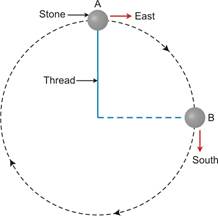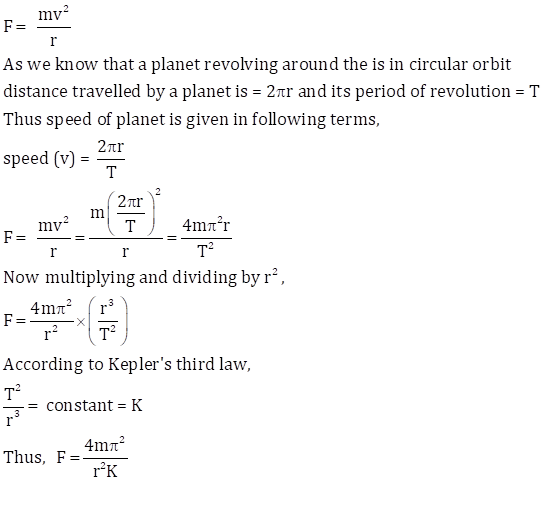Class 10 MAHARASHTRA STATE TEXTBOOK BUREAU Solutions Science Chapter 1 - Gravitation
Gravitation Exercise Ex. 1
Solution 1
Solution 2a
- The mass of an object is the amount of matter present in it. Mass is same everywhere in the Universe and is never zero. It is a scalar quantity and its SI unit is kg.
- The weight of an object is the force with which the earth (or any other planet/ moon/star) attracts it.
- It is directed towards the centre of the earth. The weight of an object is different at different places on the earth. It is zero at the Earth's centre. It is a vector quantity and its SI unit is the newton (N). The magnitude of weight is W= mg.
- The mass of an object will be the same on the earth and Mars, but the weight will not be the same because the value of g on Mars is different from that on the Earth.
Solution 2b
- Free fall:
Whenever an object moves under the influence of the force of gravity alone, it is said to be falling freely. - Acceleration due to gravity:
The acceleration produced in a body due to the gravitational force of the earth is called the acceleration due to gravity. - Escape velocity:
When a body is thrown vertically upward from the surface of the earth, the minimum initial velocity of the body for which the body is able to overcome the downward pull by the earth and can escape the earth forever is called the escape velocity. - Centripetal force:
In uniform circular motion of a body, the force acting on the body is directed towards the centre of the circle. This force is called centripetal force.
Solution 2c
Kepler's Law of Planetary Motion are:
- Kepler's First Law (Law of Orbit): Every planet revolves around the sun in an elliptical orbit. The sun is situated at one focus of the ellipse.
- Kepler's Second Law (Law of Area): The radius vector drawn from the sun to a planet sweeps equal areas in equal interval of time i.e., the areal velocity of the planet around the sun is constant.
- Kepler's Third Law (Law of Period): the Square of the time period of revolution of a planet around the sun is directly proportional to the cube of semi major axis of the elliptical orbit i.e., T2⍺ R3
A force acting on an object moving along a circle and directed towards the centre of the circle is called centripetal force.

If the mass of an object in circular motion is m, v is speed and r is the radius of the circular path, then the centripetal force is given by

Solution 2d
We need to use the equations of motion,
v = u + a × t .....................(1)
v2 = u2 + 2×a×S .................(2)
where v is final velocity after time t, u is initial velocity, a is acceleration and S is distance travelled in time t.
Let u be the initial projection velocity of stone.
when the stone reaches the maximum height after time t, its final velocity is zero.
When the stone travelling vertically upwards, it is experiencing the retardation due to gravity.
hence, we write the above equation of motion (1) as,
0 = u - g × t or t = u/g .............(3)
eqn. (2) will be written as, 0 = u2 - 2×g×h, or
![]() ...................(4)
...................(4)
by substituting u from eqn. (4) in eqn. (3), we have

After reaching maximum height, the stone descends with zero initial velocity, accelerated downwards due to gravity and reaches the ground after time t'.
Eqns. (1) and (2) are written as follows for downward travel
v = 0+gt' or t' = v/g ..........................(6)
v2 = 0+2gh or
![]() .....................(7)
.....................(7)
from eqn. (4) and eqn. (7), we can conclude that initial projection velocity and
final velocity when the stone reaches the ground are equal
by substituting for v from eqn. (7) in eqn. (6), we get,
![]() ................(8)
................(8)
from eqn. (5) and eqn. (8), time of ascending the height h is equal to time of descending from same height h
Solution 2e
- To pull the heavy object along the floor, it is necessary to do work against the force of friction. This force of friction is proportional to the weight, mg, of the object.
- If the value of g becomes twice its value, the weight of the object and hence the force of friction will become double. Therefore, it will become two times more difficult to pull a heavy object along the floor.
Solution 3
The general equation for acceleration due to gravity 'g' is
![]()
The value of g also changes if we go inside the Earth. So, in this case, the value of r (radius) decreases and the value of g also decreases as the part of the Earth which contributes towards the gravitational force experienced by the object decreases.
Thus, at the centre if earth the value of g is zero.
Solution 4
According to Kepler's law,
T² is directly proportional to R³
Here T denotes the time period and a denotes the radius of revolution
Here when the radius of revolution is R then time period is T means
T² = kR³ [ here k is proportionality constant] ----(1)
Again,
Let the time period is T' when the radius of revolution is 2R
T'² = k(2R) ³ = k.8R³ -----(2)
Dividing equation (1) by (2)
T²/T'² = kR³/k8R³ = 1/8
T'² = 8T²square root both sides, we get
T' = √8 T
Hence, proved.
Solution 5a
s = u t + 1/2gt²
where s is the displacement, t is time, u is initial velocity, g is acceleration due to gravity
u = 0
s = 5 m
t = 5 s
Substituting in the formula we have,
5 = 1/2 × 25 × g
5 = 12.5g
g = 0.4 m/s²
Solution 5b
rA = ½ rB and gB = ½ gA
GMB/rB2 = ½ GMA/rA2
MB/4rA2 = ½ MA/rA2
MB = 2MA
Solution 5c
Mass on the earth = 5 kg
Thus, weight on the Earth (WE) = 49 N
Acceleration due ti gravity on moon = 9.8 / 6 = 1.63 m/s2
Mass of object is independent of gravity and it remains same everywhere i.e., 5 kg (for the given object)
Wm = 5 x 1.63 = 8.15 N
Thus, on moon, the mass of object will be 5 kg and weight will be 8.15 N
Solution 5d
We know,
v2 = u2 + 2as … (third equation of motion)
a = - 10 m/s2 (as object is going up against the acceleration due to gravity of the earth)
02 = u2 + 2 (-10) (500)
Thus,
u2 = 10000
u = 100 m/s
From Newton's first law of motion,
v = u + at
0 = 100 + (-10 t)
t = 100/10 = 10 s
Total time = time of ascent + time of descent
= 10 + 10 = 20 s
Thus, total time taken by object to come back to earth is 20 s.
Solution 5e
Velocity on reaching the ground
v = u + g t
v = 0 + 10 × 1 = 10 m/s
Height of table
s = ut + ½ gt2 … (by second equation of motion during freefall)
s = 0 + 5 =5 m
Speed of ball on reaching ground is 10 m/s and height of table is 5 m.
Solution 5f
Mass of the earth = 6 × 1024 kg
Mass of the moon,
m = 7.4 × 1022 kg
the distance between the earth and the moon,
d = 3.84 × 105 km
= 3.84 × 108 m
G = 6.7 × 10-11 Nm2kg-2
F = GM m/d2

Solution 5g
Mass of the earth (ME) = 6 × 1024 kg
Gravitational force (F) = 3.5 × 1022 N
R = 1.5 × 1011 m
G = 6.7 × 1011 Nm2/kg2
F = G MeMs/R2
The mass of the Sun is 1.96 × 1030 kg

